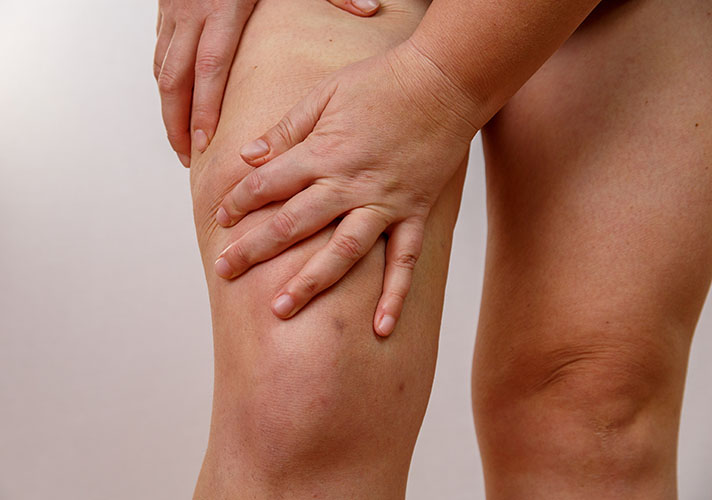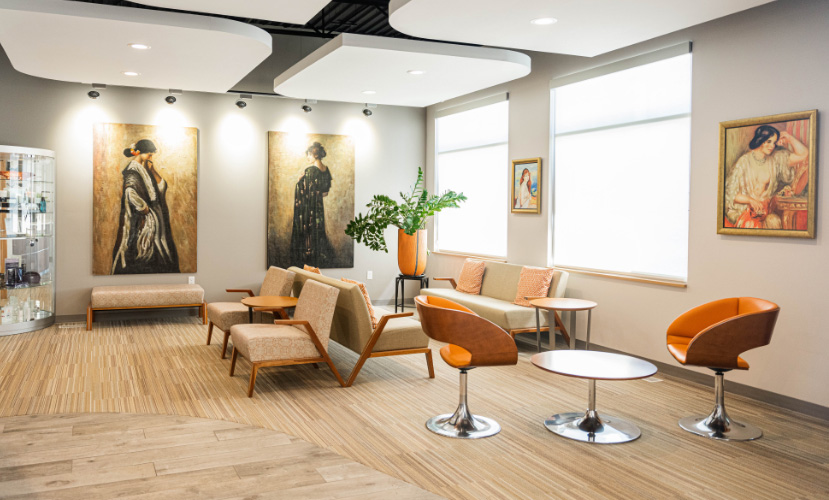Lymphedema Treatments
The “flaw” in the lymphatic system is that there are no drains along the path of lymph travel other than the central one in the chest. The obstruction of a lymphatic vessel causes the lymph to drain out into the tissue surrounding it, causing swelling, weight, and pain in the limbs. Fluid buildup is unhealthy and causes inflammation and irritation. If left untreated for too long, the fluid causes scarring and even turns to solid adipose tissue – fat. Lymphatic vessels will continue to drain into the limb, perpetuating the patient’s discomfort.
At Advanced Plastic Surgery, we most often see patients in Grand Rapids who have acquired lymphedema through surgical complications associated with surgical cancer treatments such as mastectomy with lymph node biopsy or dissection. Fortunately, there are certain courses of action that can be taken to keep the chronic effects of lymphedema under control.

Causes of Lymphedema
The lymphatic system is most closely related to the immune system. The cause of lymphedema stems from an injury and scarring of the lymphatic pathway or congenital malfunction or absence of lymphatic vessels and/or nodes. Physiologically, the lymphatic fluid is naturally produced at the pressure change that occurs when blood vessels naturally diverge and narrow into smaller vessels along the length of arms and legs. Fluid can leak out of these vessels and into the surrounding tissue due to pressure changes in the limbs. Luckily, the lymphatic system picks up these fluids and transports them in lymphatic vessels. These vessels then carry lymph up the length of the arm while passing through small lymph nodes which act like white blood vessel-filled filtration stations. Once the fluid reaches the chest, it drains back into large blood vessels and restarts the filtration system. However, there are no other drainage points along the lymphatic vessels’ route to the chest into which they can empty. A problem arises when the lymph vessels, traveling toward the chest become obstructed. The fluid then has nowhere to drain, causing it to drain into the skin and creating a prominent swelling effect.
Obstructions of the lymphatic system do not occur spontaneously (except in congenital diseases). Surgeries to control and treat breast cancer and gynecological cancer can sever lymphatic vessels or require the removal of lymph nodes situated in the armpits and genital area. These procedures often influence one arm or leg depending on the incision. Risks for lymphedema are heightened by obesity, with a major signifier of lymphedema being swelling. Pitting edema is a phenomenon where pitting is observable when pressure is applied to the area of fluid buildup. This edema may respond to physiologic surgical procedures, such as lymphatic venous bypass surgery and lymph node transfer or traditional therapy. When there is no pitting upon pressure application, we are likely dealing with lipoedema where the baked-up fluid is transformed into fatty tissue. These cases may be amenable to reduction surgery, such as liposuction or sometimes excision.
No single type of surgery or therapy is effective for all patients, and the treatment and surgery must be individualized care for every patient to achieve maximum benefit. Many of Dr. Timek’s patients have been able to achieve complete reductions in volume and were able to abandon therapy or compression. However, other patients are required to undergo additional surgeries and maintain therapy and compression.
Treatment Options
Though this disease is not fully curable, various treatment options can minimize the severity of the disease. One such treatment is lymphatic venous anastomosis which entails reconnecting lymph vessels with blood vessels to allow fluid to drain from the limbs. Special visualization techniques are used to map the vessels and lymph nodes on the skin before any incisions are made. Moreover, the incisions are about an inch and a half large, making scarring minimal. Few plastic surgeons are trained in the field of microsurgery to conduct these procedures. Dr. Timek possesses the skills to conduct such procedures. For later stages of lymphedema, liposuction may be an advised option to remove the fat cells that differentiated from the lymph fluid trigger under the skin.
Traditional Therapies
Traditional treatments of lymphedema may be effective in 80% of cases. Conservative therapies include manual drainage, pumping, and compression garments to push the fluid up a limb or toward a physiologically normal area and prevent fluid buildup. Early stages allow the removal of fluid so the arm or leg can return to its normal proportions. However, these options treat the symptoms of lymphedema (fluid buildup) rather than the cause itself of disconnected lymphatic vessels. This can require surgical intervention.
Acquired lymphedema can arise from the surgical treatment of cancer, for preventative measures include removing the parts of the immune system that may house colonies of cancer cells- the lymph nodes. The excision can unintentionally obstruct drainage pathways for the lymph, and so the swelling occurs. Cancer and radiation treatment can also do damage to the lymphatic system. If in the earlier stages, the vessels themselves can be salvaged and reconnected to lymph nodes via microsurgery. However, later stages of the disease cause the vessels to solidify. Moreover, fluid released from the disconnected lymph vessels prompts adipocyte precursor cells to differentiate into fat cells, populating the mass of fluid with a permanent mass of fat.
Surgical Therapies
- Lymphaticovenous Bypass: One of the most specialized and effective surgical treatments is a lymphatic venous bypass (LVB). It requires healthy, working lymphatic channels that have not yet undergone permanent damage or solid-state transformation. The procedure entails connecting the severed lymphatic vessels in the arms and legs to the tiny veins. This bypass reconnects the lymphatic fluid pathway and redirects lymphatic fluid back to the veins and chest. With the use of a microscope, Dr. Timek conducts this procedure to decrease swelling, feelings of heaviness, pain, and discomfort to reduce or eliminate the swelling of your limbs.
- Lymph Node Transfer: Another therapy for the treatment of arm or leg lymphedema is lymph node transfer surgery. This procedure transfers lymph nodes harvested from another part of the body and places them in the lymphedematous limb. Lymph nodes are transferred with their blood flow system containing arteries and veins, which need to be restored under a microscope. The transferred lymph node acts like a sponge “sucking” excessive lymphatic fluid back into its vein. Lymph node transfer restores proper lymphatic flow and reduces the swelling associated with lymphedema. Lymph node transfer usually requires a short hospital stay but is usually well tolerated by the patient. One significant risk of lymph node transfer is the possibility of causing lymphedema in the limb the lymph node that was harvested from. Cases of secondary lymphedema after lymph node transfer is rare.

What is Lymphedema?
Lymphedema is a lifelong, chronic disease of the lymphatic system caused by clogged lymphatic vessels in which tissues swell due to an acquired (rarely congenital) disease of the lymphatic system which can result from cancer surgery, radiation therapy, or a combination of the two. The most prominent symptom of lymphedema is swelling of the upper or lower extremities, sometimes even accumulating 2-3 liters of fluid in one limb.
As arteries carry blood down the length of our limbs, the vessels diverge into smaller arterioles and capillaries in the fingers and toes, with the blood coming back to the heart using veins. There is a change in pressure between the arterioles and small veins that forces some fluid, called lymph, out of the vessels into the outside tissue. The lymph is picked up by lymphatic vessels which carry the fluid back into the big chest veins to recirculate, passing through lymph nodes, little pockets of white blood cells which filter out impurities in the fluid.
The diagnosis of lymphedema can be an unforeseen consequence of cancer-fighting therapies, a factor that can potentially bring down the morale of the patient. It is crucial to keep a positive mindset at the forefront of the treatment plan, focusing on the solutions and treatments for the problem. Dr. Timek and the staff at Advanced Plastic Surgery will address all your concerns, knowledgeably direct you toward the best therapeutic options, and provide emotional support all along the way.
What are the Benefits of Lymphedema?
Our patients have seen the following benefits from their lymphedema surgery in Grand Rapids:
- Improvement in activities of daily living
- Improvement in psychological well-being
- Reduction of excess volume
- Reduction in the risk of dangerous infections such as cellulitis
- Restoration of the ability to wear normal clothing or footwear
- Reduction in social stigma of Lymphedema
Who are the Best Candidates for Lymphedema?
The best candidates for Lymphedema treatment in Grand Rapids are patients who:
- Are cancer patients without tumor recurrence or distant metastasis
- Are experiencing Lymphatic obstruction
- Have aggressively received rehabilitation for more than six months with no significant improvement
- Have a different circumference of more than 10% between affected and non-affected limbs
Lymphedema surgeries have standard surgical risks compared to other surgical procedures of a similar length of time. Most patients have experienced an improvement in their symptoms after Dr. Timek’s surgeries.
Patients who are severely overweight tend to have higher surgical risks and less favorable surgical outcomes with any type of surgery, including Lymphedema surgery. For our patients who are severely overweight, we recommend weight loss first as the Lymphedema can tremendously improve with weight loss alone.
– Ewa Timek, MD


What’s The First Step?
AT ADVANCED PLASTIC SURGERY
The first step in getting treatment for Lymphedema in Grand Rapids is to contact Advanced Plastic Surgery and schedule a consultation with Dr. Timek. During this appointment, you will be able to discuss how your lymph blockage is affecting you and ask any questions you may have about the condition or treatment possibilities. After giving you an examination and discussing your medical and surgical history, Dr. Timek will be able to create a treatment plan that will be perfectly matched to your needs. If you agree with her assessment and would like to follow through with your treatment, our Patient Coordinator will be able to help you schedule the day and time for your treatment. You will be given some directions to follow before coming back so that you will have the most successful procedure results possible.

What to Expect on the Day of Lymphedema
Before the procedure, a green dye called Indocyanine Green (ICG) is injected into the limb to make the lymphatic vessels visible to a special scanner, Hamamatsu Photodynamic Eye (PDE). Dr. Timek uses PDE to visualize the vessels and draws them out on the surface of the skin with a marking pen. She can see places of fluid buildup with the device, allowing her to make precise incisions to target the obstructed lymphatic vessel. The vessel is joined with a neighboring vein under the microscope due to the very small size of lymphatics, measuring about 0.3-1 millimeter in diameter. Only small incisions overlaying the targeted lymphatics are necessary. Lymphaticovenous bypass (LVB) restores the filtration circuit and eliminates the potential for unwanted drainage to occur. This surgery is associated with low risk and does not require a hospital stay. LVB requires about 2 years for optimal results, given that permanent vessel damage has not yet occurred. Frequent massage resumed after 1 month after surgery is also advised to stimulate the flow of lymph in the newly connected pathway.
Lymphedema Treatment Recovery
If you have just undergone radiation therapy or had surgery for cancer, key preventative measures include keeping the limb raised above the heart to induce a downward flow of fluid. Refrain from applying ice or wearing tight clothing. In the event of lymphedema-associated swelling, consult your doctor as soon as possible to arrange a visit and potential diagnostic tests such as lymphoscintigraphy or MRI. Compression garments, bandages, or pumps are also advised to help fluid flow and prevent buildup. Exercise in moderation is also advised to strengthen the body as it compensates for the internal loss of function.

Average Cost
How Much Does Lymphedema Treatment Cost in Grand Rapids, MI?
The cost of Lymphedema treatment in Grand Rapids is largely dependent on the technique Dr. Timek uses and the severity of your Lymphedema, among other factors. After you come in for your consultation, Dr. Timek will have a better understanding of what you need and how to help you. When she collects all this information and makes your treatment plan, our Patient Coordinator will be able to give you a cost breakdown.
Insurance coverage for Lymphedema surgery depends on your insurance policy and your Lymphedema condition. Dr. Timek’s care team is dedicated to helping patients navigate various insurance issues. We highly recommend patients also seek assistance from their health advocates.
Why Choose
Advanced Plastic Surgery
To conduct lymphatic venous bypass and lymph node transfer surgery, refined microsurgical techniques are required. Dr. Timek, having completed her Fellowship in Microsurgery at Stanford University, has studied lymphedema treatments with microsurgery at the world’s leading institutions in Seattle, Tokyo, and Geneva. She has conducted research and attended conferences on the subject, furthering her knowledge of lymphedema while educating herself and discussing potential options with others.

Become a Patient
contact us
Living with Lymphodema can be very uncomfortable and sometimes painful for patients. If you are interested in getting treated for Lymphodema in Grand Rapids, contact Advanced Plastic Surgery and schedule your consultation. You can call our clinic at (616) 323-3102 or request an appointment through our website, and one of our wonderful and knowledgeable team members will be in touch with you.
Patient Resources
Advanced Plastic Surgery
We’re here to help, with a number of patient resources designed to make your experience as comfortable as possible. Read through the materials below, and don’t hesitate to reach out.

